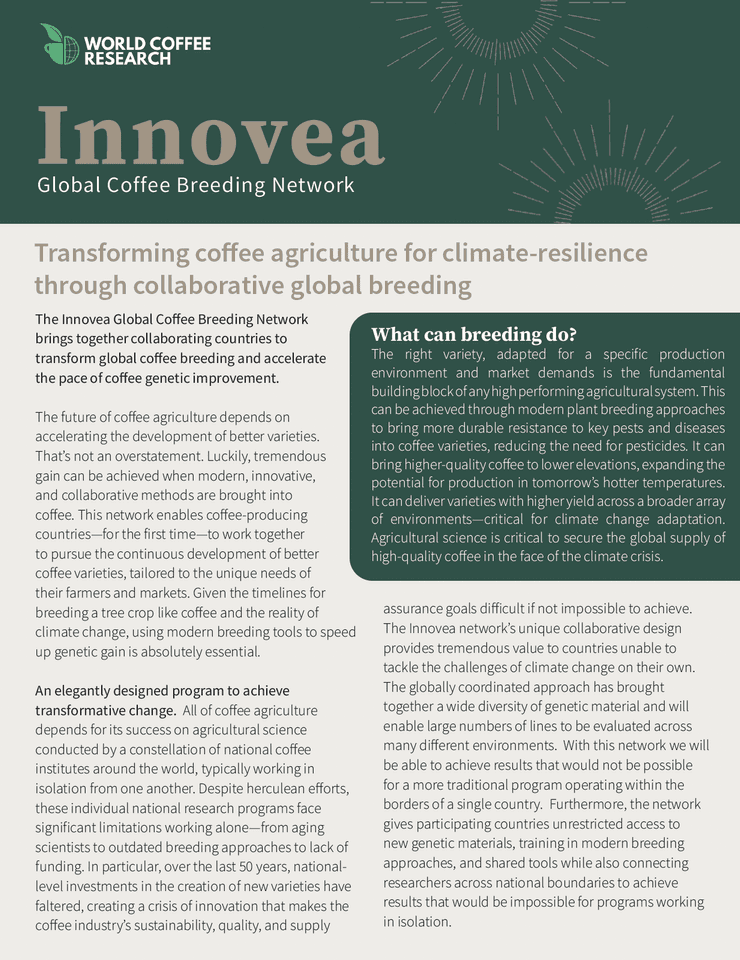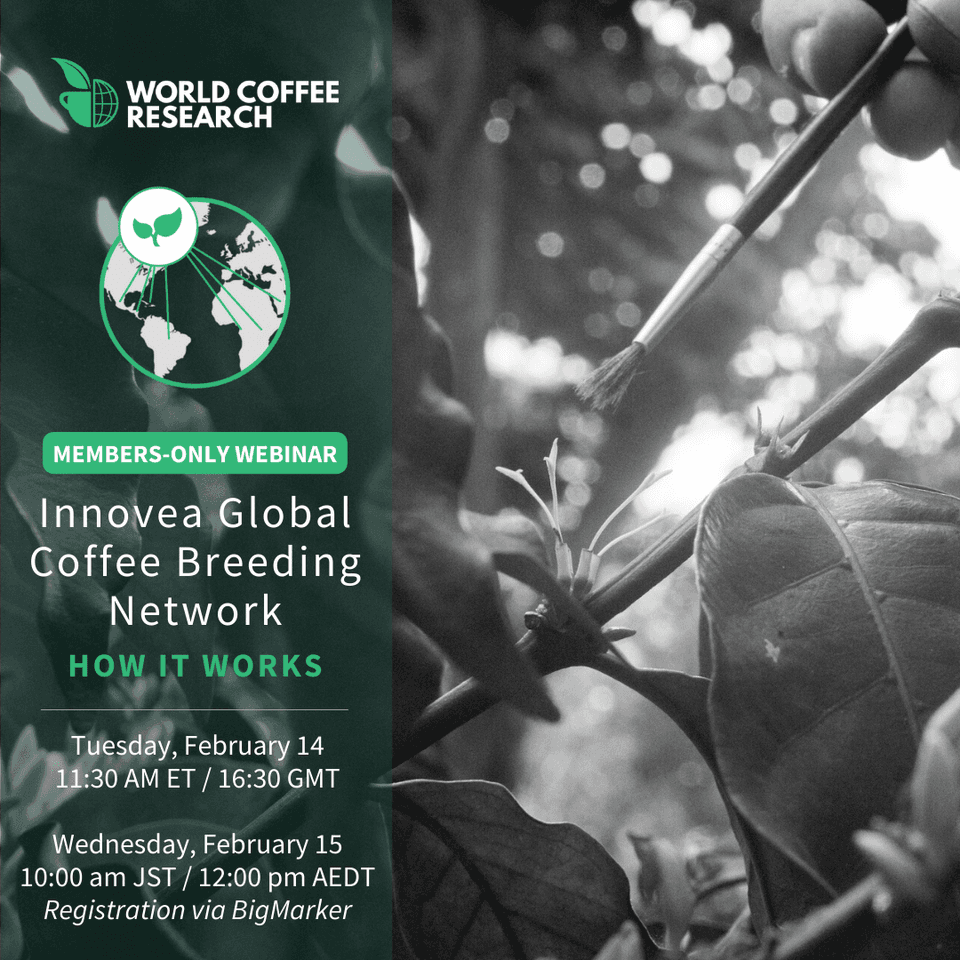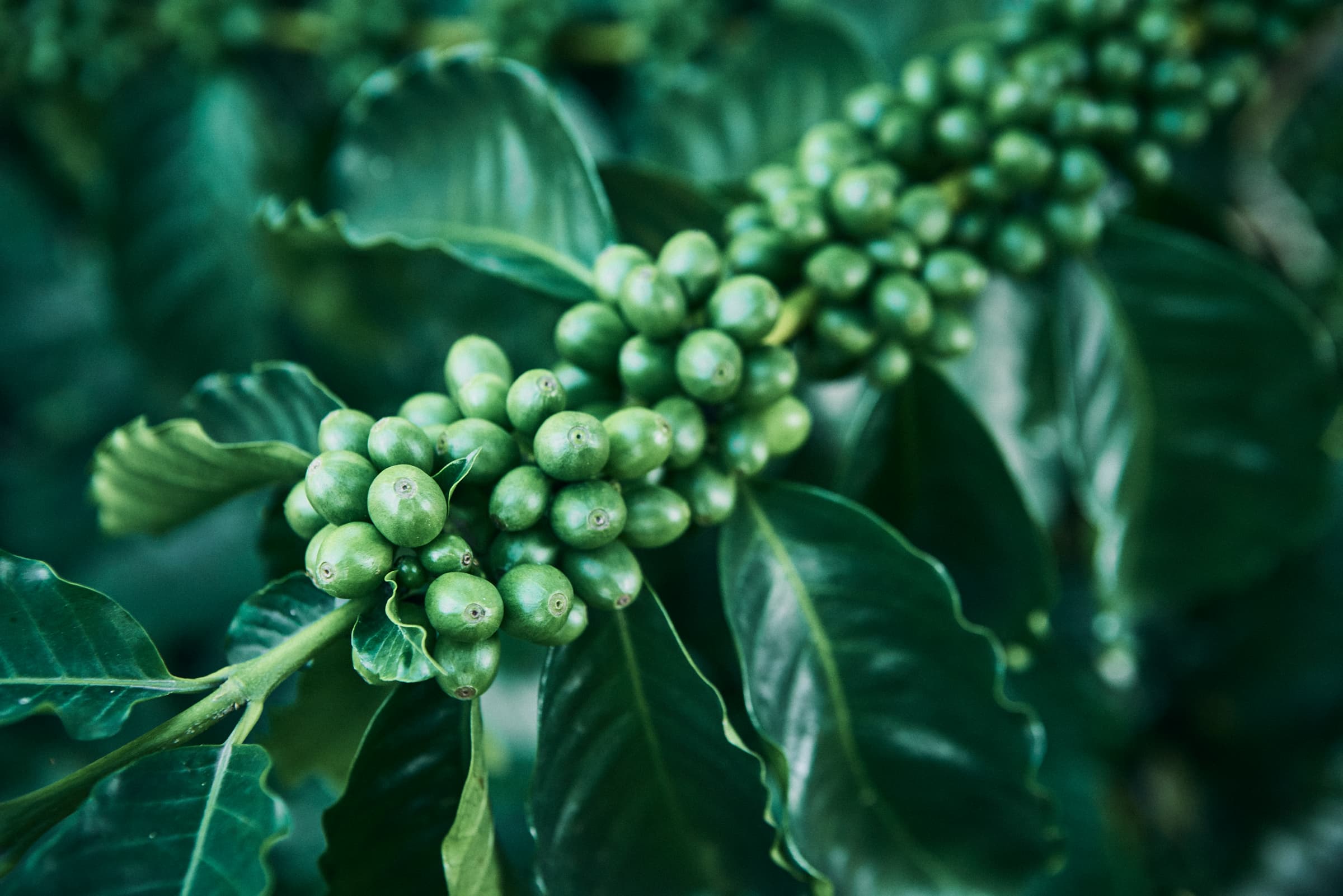- Indonesian Coffee and Cocoa Research Institute (ICCRI)
- USDA Agricultural Research Service
- Instituto del Café de Costa Rica (ICAFE)
- Kenya Agricultural & Livestock Research Organization (KALRO)
- Central Coffee Research Institute (CCRI)
- National Coffee Research Institute (NaCORI)
- Rwanda Agriculture and Animal Resources Development Board (RAB)
- Instituto Nacional de Innovación Agraria (INIA)
Breeding
Innovea Global Coffee Breeding Network
Transforming coffee agriculture for climate-resilience through collaborative global breeding
The Innovea Global Coffee Breeding Network brings together collaborating countries to transform global coffee breeding and accelerate the pace of coffee genetic improvement.
Problem
With a business-as-usual approach, current coffee breeding programs are overtaken by the challenges of climate change and will be unable to generate innovations quickly enough to respond to the growing challenges faced by farmers.
All of coffee agriculture depends, for its success, on agricultural science conducted by a constellation of national coffee institutes that typically work in isolation from one another due to the way in which breeding activities enhance origin competitiveness in the market. Despite herculean efforts, these individual national research programs face significant limitations working alone—from aging scientists to outdated breeding approaches to a lack of funding. In particular, over the last 50 years, national-level investments in the creation of new varieties have faltered, creating a crisis of innovation that makes the coffee industry's sustainability, quality, and supply assurance goals difficult, if not impossible, to achieve.
The coffee community requires a different approach to coordinating and implementing coffee breeding if we are to succeed in improving coffee quality and securing long-term supply in the face of the climate crisis.
Solution
The Innovea Global Coffee Breeding Network brings together collaborating countries to transform global coffee breeding and accelerate the pace of genetic improvement in coffee. This network enables coffee-producing countries to work together to pursue the continuous development of better coffee varieties, tailored to the unique needs of their farmers and markets.
Given the timelines for breeding a tree crop like coffee and the reality of climate change, using modern breeding tools is absolutely essential. The Innovea network's unique collaborative design provides tremendous value to countries unable to tackle the challenges of climate change on their own. The globally coordinated approach has brought together a wide diversity of genetic material and will enable large numbers of lines to be evaluated across many different environments. With this network, we will be able to achieve results that would not be possible for a more traditional program operating within the borders of a single country. Furthermore, the network gives participating countries unrestricted access to new genetic materials, training in modern breeding approaches, and shared tools while also connecting researchers across geographies to achieve optimized results.
Significant genetic gains can be achieved with existing coffee germplasm if modern breeding approaches are brought into coffee. The cornerstone of WCR’s strategy is that the Innovea network will bring together the capacities of participating countries to accelerate the pace of coffee genetic improvement. In this network, collaboration enables deeper competitiveness among coffee producing country partners, and breeding will simultaneously respond to the needs of farmers and of roasters and consumers.
Modern coffee breeding can solve multiple problems at once. For example, it will bring more durable resistance to key pests and diseases into coffee varieties, reducing the need for pesticides. It can bring higher-quality coffee to lower elevations, expanding the potential for production in tomorrow’s hotter temperatures. It can deliver varieties with higher yield stability across a broader array of environments—critical for climate change adaptation—and/or tailored to specific environments.
Impact
Using the latest technologies available for crop improvement, the Innovea Global Coffee Breeding Network will drive a transformation in the global coffee supply. Through a demand-led breeding approach, together, the industry and farmers will design the coffee of the future. In the next two decades, we expect that multiple countries will have a basket of improved varieties that are more productive and climate resilient, better tasting, and more diverse than all of today’s current varieties. From then on, there will be a continuous pipeline of ever-improving more stable/predictable and diverse available to farmers through their national research institutions.
Key features of the Innovea Global Coffee Breeding Network
Nine global partners. Costa Rica, USA, India, Indonesia, Kenya, Mexico, Peru, Rwanda, and Uganda are the network participants. These collaborators together produce ~23% of the world’s arabica coffee exports.
Population development & finished varieties. The network’s primary focus is on the development of genetically diverse breeding populations, which are distributed to network participants every 6 years to continually replenish national breeding programs with superior breeding material. Participating countries remain in charge of the development and release of finished varieties tailored for local conditions and niche market demand. WCR also supports partners via investments in capacity building.
Time-to-farmers. Finished variety development is a long-term endeavor. Depending on the breeding approach and the performance of the material, some countries could release new varieties as early as 2033. Most will take several more years. After that, new varieties can be released in a country as often as every 3-5 years.
Cooperation + Competition = Coopetition. The network’s collaborative design lowers the cost for individual countries to access modern breeding tools (cooperation), while countries remain in the driver’s seat regarding finished variety selection and variety release to give their farmers a competitive edge (competition).
New and unique genetic combinations. WCR will create new, improved breeding populations that partners can use without restrictions on their use.
Modern breeding. The network will use genomic selection with recombination centralized at WCR’s breeding factory in Costa Rica, to create improved populations as fast as possible. Each new population cycle will recombine individuals with the highest breeding values across traits. Phenotyping is carried out by partners at globally distributed sites. These approaches allow breeders to tackle multiple problems simultaneously (such as yield, disease resistance, cup quality, and climate resilience) and to speed up improvement. Note: The breeding network will not engage in genetic modification.
Demand-led. Using principles of demand-led breeding ensures that finished varieties are ones farmers want to grow and that roasters and consumers want to buy.
Multi-environment testing for climate resilience. Breeding populations will be distributed to sites in many countries with different agroecological environments, exposing them to diverse and sometimes extreme environmental pressures. Aggregated global performance data will indicate which plants have stable performance across climates. The most stable plants can be released for farmers and can be used in subsequent breeding to increase climate resilience traits to make even better varieties.
Funded by the coffee industry. The network is funded by the 200+ member companies from 27 countries that make up World Coffee Research. These companies are leaders in the global coffee industry driving science-based agricultural solutions to urgently secure a diverse and sustainable supply of quality coffee today and for generations to come.
Collaboration + Competition = Coopetition
We propose that transformation of the world’s coffee breeding infrastructure requires a “coopetition” model.
- Collaboration. The key factors – larger population sizes with greater diversity than is normally achieved through simple two-parent populations, diverse production environments in which to test material, and phenomic and genomic selection tools to improve precision of selection and shorten selection cycles – require broad, global collaboration. In particular, true climate resilience requires that countries work together. Even if individual countries have the best molecular tools and a high-powered breeding program, they are limited to evaluating breeding material in their own existing production environments—they will not be able to see how genes within plants perform when a hotter/wetter/drier/colder production environment arrives on their doorstep, at which point it will already be too late.
- Competition. At the same time, national breeding efforts are fundamentally part of producing countries’ competition with one another. Many have ambitious goals to expand both exports and domestic consumption.
- Coopetition. In a “coopetition” framework, deeper collaboration enables deeper competitiveness among participating national programs. The model offers a new way for producing countries obtain access to best-in-class technology and climate resilient germplasm, while also supporting national competitive ambitions.


The Innovea Network
Our Partners
Below are the countries and partners currently participating in the Innovea Global Coffee Breeding Network.
Asia
Indonesia
Indonesian Coffee and Cocoa Research Institute (ICCRI)
ICCRI was established in 1911 and has played an active role in the research and development of coffee and cocoa in Indonesia for more than a century. In 2013, the national Ministry of Research and Technology declared ICCRI a Center of Excellence (CoE) for coffee.
North America
United States
USDA Agricultural Research Service
The Agricultural Research Service (ARS) is the U.S. Department of Agriculture's chief scientific in-house research agency. Their mission is to deliver scientific solutions to national and global agricultural challenges, from field to table.
Latin America
Costa Rica
Instituto del Café de Costa Rica (ICAFE)
The Instituto del Café de Costa Rica (ICAFE), founded in 1933, regulates all coffee activities and is a source of innovation, investigation, and technological development in commitment with the environment in all the coffee sectors of Costa Rica.
Africa
Kenya
Kenya Agricultural & Livestock Research Organization (KALRO)
KALRO conducts research to catalyze sustainable growth and development in Kenya’s agriculture sector. Kenya has one of the longest histories of formal coffee research in the world, commencing in 1908.
Asia
India
Central Coffee Research Institute (CCRI)
CCRI, established in 1925, is the research and extension arm of the Coffee Board of India. CCRI is located in the heart of Karnataka, India’s most important coffee region.
Africa
Uganda
National Coffee Research Institute (NaCORI)
NaCORI conducts and manages basic and applied research for coffee in support of national goals to increase the value of coffee exports. NaCORI is one of 16 public agricultural research institutes of the National Agricultural Research Organization (NARO), and has been named a Center of Robusta Excellence.
Africa
Rwanda
Rwanda Agriculture and Animal Resources Development Board (RAB)
RAB develops agriculture and animal resources through research, agricultural extension, and animal resources extension in order to increase agricultural and animal resources productivity and quality, as well as their derived products.
Latin America
Peru
Instituto Nacional de Innovación Agraria (INIA)
